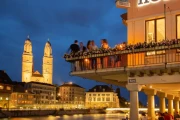Generated Title: Zurich's "Top-Tier Underwriting Talent": Are They Real, or...
2025-11-09 29 zurich
Okay, friends, let's talk about Zurich. I know, I know, Switzerland might conjure up images of chocolate, watches, and… well, maybe a certain reputation for being a bit sleepy. But trust me, something incredibly exciting is brewing beneath the surface. It's a quiet revolution, a testament to Swiss ingenuity, and it’s building the future right under our noses.
Forget the clichés for a moment. We're talking about a city that's not just preserving its heritage, but actively designing its tomorrow. Think of it like this: Zurich isn’t just a beautiful antique; it's an antique store that's secretly building a spaceship in the back room.
We see it in Santiago Calatrava's stunning Haus zum Falken, the angular glass office building rising beside Stadelhofen Station. It’s more than just architecture; it's a statement. Calatrava himself says it best: "Architecture here is more than functional – it is an artistic event in the city." That meandering glass facade, the way it plays with light and space... it's not just pretty; it's a vision of how urban spaces can be both efficient and inspiring, and how design can elevate the everyday. It’s a reminder that beauty has a function. For more information, see Santiago Calatrava adds angular glass office building to Zurich station.
And speaking of function, that building also houses a three-story bicycle parking facility for 800 bikes below ground. It's a subtle detail, but it speaks volumes about Zurich's commitment to sustainable living, to weaving green solutions into the very fabric of the city. How many cities do you know that are this dedicated to integrating cycling into their urban planning? It's not just about bike lanes; it's about rethinking urban spaces to prioritize people and the planet. Which makes you wonder, how can other cities learn from this holistic approach to urban development?
But the innovation doesn't stop there. Consider Zurich Airport. Most of us just see it as a place to catch a flight, right? But an aerial view reveals a runway system so complex, it's considered one of the most intricate in Europe. "Add in noise abatement procedures and political constraints, and you get one of Europe’s most intricate and fascinating airfields to manage," as one Reddit user pointed out.
It's a beautiful mess, a testament to human ingenuity solving incredibly complex problems. The airport isn't just moving people from point A to point B; it's orchestrating a symphony of logistics, balancing efficiency, safety, and environmental concerns. It's like watching a master chess player anticipate every possible move.
And then, there's the digital frontier. The news that a Swiss bank, Habib Bank AG Zurich, was targeted by hackers, with a massive 2.5 TB of data allegedly stolen, is a stark reminder of the challenges we face in this increasingly connected world. But even here, I see an opportunity. This is a wake-up call, a chance to strengthen our defenses, to innovate in cybersecurity, and to build a more resilient digital future. It forces us to ask: How can we transform these security threats into opportunities for innovation in data protection and cybersecurity?

The key takeaway? Zurich isn't just a pretty picture; it's a living laboratory, a place where challenges are met with innovation, where beauty and function intertwine, and where the future is being built, piece by piece, day by day.
It reminds me of the Renaissance. Florence wasn't just a city; it was a hotbed of creativity, a place where art, science, and culture converged to create something truly extraordinary. Zurich, in its own quiet way, is becoming a similar kind of hub, a place where innovation is not just a buzzword, but a way of life.
And that's why I find Kevin Magnussen's move to Zurich so interesting. The former Formula 1 driver is now investing in Racing Unleashed, a Swiss motorsport simulator company. He sees it as a way to democratize racing, to make it accessible to more people. "Until now, motorsport was only for the rich," he says. "Thanks to the simulators, racing is finally becoming more accessible to thousands of talented people out there."
What this says to me is that Zurich is attracting talent from all over the world. It's a place where people are not just making money, but also making a difference, where they're using their skills and resources to build a better future.
So, what does all of this mean? It means that Zurich is more than just a city; it's a model, a blueprint for how we can build a better future. It's a reminder that innovation is not just about technology; it's about people, about culture, and about a commitment to creating a more sustainable, equitable, and inspiring world. It's a challenge to ask ourselves: How can we replicate Zurich's success in our own communities?
Of course, with great power comes great responsibility. As we embrace these new technologies and innovations, we must also be mindful of the ethical implications. We need to ensure that technology serves humanity, not the other way around.
But the potential is there, and it's thrilling. When I look at Zurich, I don't just see a city; I see a glimpse of what the future could be. And honestly, it fills me with hope.
The future is not something that just happens to us. It's something we build, together. And Zurich is showing us the way.
Tags: zurich
Related Articles

Generated Title: Zurich's "Top-Tier Underwriting Talent": Are They Real, or...
2025-11-09 29 zurich